 THE MINERAL DANBURITE
THE MINERAL DANBURITE
- Chemistry: CaB 2 Si 2 O 8 , Calcium boron silicate
- Class: Silicates
- Subclass: Sorosilicates
- Uses: mineral specimen
Specimens
Danburite is not a well-known mineral but is growing in popularity. With crystals similar to topaz, danburite offers a unique opportunity for a collector who likes perfectly transparent crystal clusters. People who admire clear quartz will like the different look of danburite. Its diamond-shaped cross-section and wedge like termination is a contrast to quartz's hexagonal prisms and pyramidal terminations. Danburite's original locality is now buried under the city of Danbury, Connecticut.
PHYSICAL CHARACTERISTICS:
- Color is almost always clear or white, but also can be shades of yellow, pink and brown.
- Luster is vitreous.
- Transparency: Crystals are transparent to translucent.
- Crystal System is orthorhombic; 2/m 2/m 2/m
- Crystal Habits include generally prismatic crystals with a diamond-shaped cross-section. The termination is a steeply slanted dome producing a wedge look. Crystals can be rather thin to almost acicular or up to a foot long and several inches across.
- Cleavage is poor in one direction, basal.
- Fracture is uneven to conchoidal.
- Hardness is 7 - 7.5
- Specific Gravity is approximately 3.0 (average)
- Streak is white or colorless.
- Associated Minerals are quartz, feldspars, cassiterite, dolomite, corundum variety ruby, and fluorite.
- Notable Occurrences include Danbury, Connecticut and Russell, New York, USA; Charcas, San Luis Potosi, Mexico; Kyushu Is., Japan; Mogok, Burma and Uri, Switzerland.
- Best Field Indicators are crystal habit, poor cleavage, hardness and associations.
 Amethyst Galleries' Mineral Gallery MINERALS |
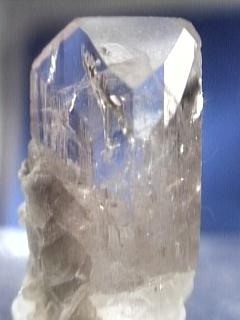
DANBURITE specimen dan-1
$ 40.00
$ 40.00
Dims: 2" x 1" x 1"
Wt: 30.0 g
Charcas, San Luis Potosi, Mexico
One of the larger of our selection of Danburite crystals, this prism measures about 2" x 1" x 5/8", with a small but considerable amount of Calcite attached near its base. The crystal is transparent, with a very pale pink tinge, and though having many internal fractures, is extremely clear. Its faces are clean and one edge has a small amount of damage near the termination. The termination itself has a scratch across the smaller of its primary faces, which is actually caused by one of the fractures reaching the surface. Otherwise, it is quite clean, with minimal damage.

dan-1 ($ 40.00)
Charcas, San Luis Potosi, Mexico

DANBURITE specimen dan-2
$ 30.00
$ 30.00
Dims: 1-5/8" x 5/8" x 7/16"
Wt: 9.2 g
Charcas, San Luis Potosi, Mexico
This gem-quality specimen is distinctive in the fact that it has only one primary termination face, as most of our others each have two. Thus, this crystal terminates to a point, as opposed to termintating to a flat edge. About 3/4 of the stone's interior is fractured, but that material closest to and including the termination is quite clear. The edges are virtually damage-free, and the primary termination face has a healed-over crack from an internal fracture that is difficult to see.

dan-2 ($ 30.00)
Charcas, San Luis Potosi, Mexico
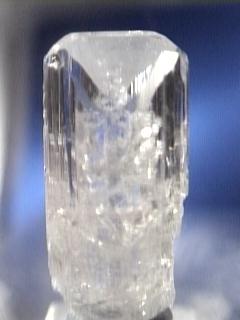
DANBURITE specimen dan-3
$ 35.00
$ 35.00
Dims: 1-7/16" x 11/16" x 1/2"
Wt: 9.7 g
Charcas, San Luis Potosi, Mexico
Although this crystal has a considerable amount of visible damage to its edges, I like it best out of our selection. About 1/3 of the material is free of internal fractures, and very clear. The termination has one tertiary face chipped off, leaving a conchoidal "scab," but the rest of the orthorombic prism is flawless and very symmetrical. I am most pleased with the secondary terminations at the tip of the crystal, reminding me of the business-end of a chisel.

dan-3 ($ 35.00)
Charcas, San Luis Potosi, Mexico
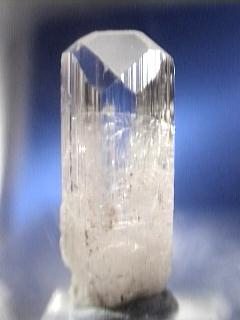
DANBURITE specimen dan-4
$ 25.00
$ 25.00
Dims: 1-1/2" x 5/8" x 7/16"
Wt: 7.4 g
Charcas, San Luis Potosi, Mexico
One of our smallest prismatic Danburite crystals, it is nonetheless a gem-quality piece. One of its edges has two conchoidal "dings" near the termination face, but all other damage is negligible. The top 1/4 of the crystal's area is free from internal fractures, and all faces are clean. I consider this crystal to be one of our better values.

dan-4 ($ 25.00)
Charcas, San Luis Potosi, Mexico
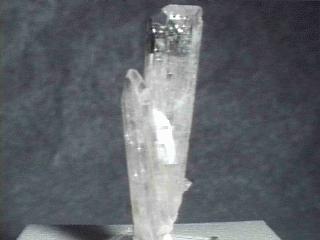
DANBURITE specimen dan-5
$ 60.00
$ 60.00
Dims: 2-13/16" x 13/16" x 11/16"
Wt: 29.7 g
Charcas, San Luis Potosi, Mexico
One of our larger specimens, this Danburite cluster is dominated by one particular crystal that is over 2-1/2" long. It is transparent and has much internal fracturing that seems to be responsible for two small spots of damage along the two opposing acute edges of the prism. Other than those spots, the crystal is relatively free of damage, as are the two smaller crystals that are growing along its prism. One of the smaller crystals is about two-thirds the length of the largest and the other is half its length. Like their larger counterpart, the two smaller crystals are transparent but show much internal fracturing. All three have clean terminations that are free of damage and have a calcite crust coating their base surfaces.

dan-5 ($ 60.00)
Charcas, San Luis Potosi, Mexico
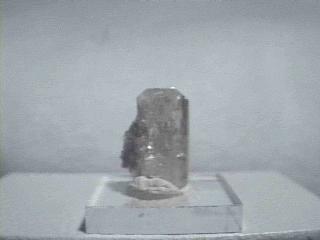
DANBURITE specimen dan-6
$ 18.00
$ 18.00
Dims: 7/8" x 1/2" x 5/8"
Wt: 4.8 g
Charcas, San Luis Potosi, Mexico
Though this little Danburite crystal has excellent clarity, good form, and no damage, it has something else that makes it very special. About one-third of the surface area of its prism is covered with tiny amethyst crystals! These crystals range in size from about 1/8" to less than 1mm and spread from the Danburite's base to just below the basal edge of its wedge-shaped termination. Their color is a pale violet at its deepest, but all of the crystals have good hexagonal prismatic form and one large one near the Danburite's termination is double-terminated. It is a small but exceptional specimen.

dan-6 ($ 18.00)
Charcas, San Luis Potosi, Mexico
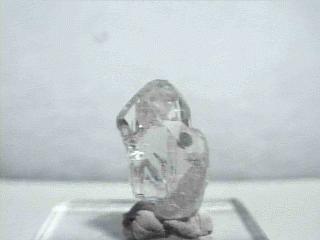
DANBURITE specimen dan-7
$ 24.00
$ 24.00
Dims: 13/16" x 7/16" x 3/8"
Wt: 2.5 g
Charcas, San Luis Potosi, Mexico
Though one of the tiniest Danburites in our selection, this is simply the most amazing. It has substantial damage to one of the acute prism edges, but all other faces and edges are clean. It is transparent with several internal fractures and flaws and a rather warped but definitely crystallographic form. The internal fractures and unusual form may be caused by the inclusion of spheroids of cookeite, a lithium and aluminum silicate hydroxide that is a member of the Chlorite group. These spheroids measure from 1/16" to 1 mm in diameter, and there are 5 or 6 of them in the crystal, including two that have hemispheroidal forms. This was the only specimen of this that we could find in which the Danburite crystal was not incomplete or heavily damaged.

dan-7 ($ 24.00)
Charcas, San Luis Potosi, Mexico
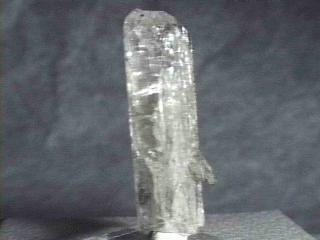
DANBURITE specimen dan-8
$ 20.00
$ 20.00
Dims: 2-1/4" x 3/4" x 1/2"
Wt: 19.6 g
Charcas, San Luis Potosi, Mexico
This particular Danburite crystal has an extraordinary amount of internal fracturing; most of the crystal's shaft is translucent at best and has a greenish gray caste because of this. The termination, however, has few fractures, and is thus transparent. There still are a few of them, however, and one has caused an irregularity in the formation of the termination's basal edge. There is a small dogtooth Calcite erupting from one of the prism faces about 1 inch from the base-- it has the same green-gray coloration as the Danburite it protrudes from. There are a few conchoidal "dings" on one of the acute prism edges near the termination, but the rest of the crystal, including the termination itself, shows no external damage.

dan-8 ($ 20.00)
Charcas, San Luis Potosi, Mexico
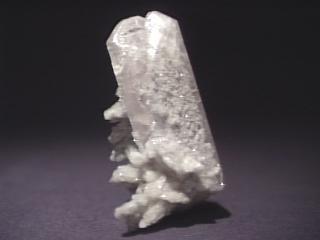
DANBURITE specimen dan-9
$ 55.00
$ 55.00
Dims: 3.0" x 1.8" x 1.8" (7.6 x 4.6 x 4.6 cm)
Wt: 2.59 oz. (73.5 g)
Mina Aurora, Charcas, San Luis Potosi, Mexico
It would appear that the large Danburite crystal in this specimen started its growth as a single crystal, then split near its top to form two intergrown but distinctly separate terminations. The crystal itself is large, measuring 2.9 x 1.0 x 0.7" (7.4 x 2.5 x 1.8 cm), and in excellent condition, showing no human-induced damage. Its orthorombic prismatic form is also very good, with the only conceivable "flaw" being the split termination. It is nearly colorless, with a faint pinkish tinge, and has a rather staid vitreous luster. It is transparent, but countless internal fractures destroy its clarity. A large portion of its surface is covered with gray-white calcite growths, mixed with pale pyrite. The growths are composed of many small, intergrown scalenohedral "dogtooth" crystals that are aligned with each other so as to create several larger "composite crystals". It is a really neat specimen!
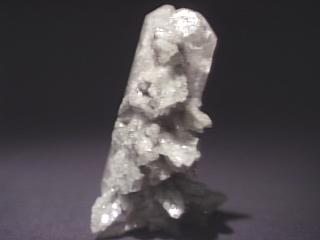

dan-9 ($ 55.00)
Mina Aurora, Charcas, San Luis Potosi, Mexico

DANBURITE specimen dan-10
$ 78.00
$ 78.00
Dims: 3.0 x 2.6 x 2.1" (7.6 x 6.6 x 5.3 cm)
Wt: 5.90 oz. (167.5 g)
Charcas, San Luis Potosi, Mexico
This hand specimen is made up almost entirely of radiating Danburite prisms. These prisms reach lengths of up to approximately 1" (2.5 cm) and are generally in very good condition, as only a small number are damaged or broken. Their orthohrombic prismatic form is excellent- all have well-defined edges and striated but clean faces. They tend to be coated with a very fine druse (possibly of quartz) which hides their bright pearly luster and gives them a subtle sparkle. All are white or colorless and translucent to dimly transparent. They rest on a base that is likely made up of quartz, as it does not react to acid. This base is also colored white, and so is difficult to define and study.

dan-10 ($ 78.00)
Charcas, San Luis Potosi, Mexico

DANBURITE specimen dan-11
$ 25.00
$ 25.00
Dims: 1.4 x 0.7 x 0.5" (3.5 x 1.8 x 1.3 cm)
Wt: 10 g
San Bartolo Mine, Charcas, San Luis Potosi, Mexico
A single Danburite crystal comprises this specimen. It is in moderately good condition, showing considerable damage along its prism length and near one corner of its termination. Its orthorhombic form is excellent, however, showing well-defined edges and clean faces. It has a pale pink coloration and a bright, vitreous luster, and is transparent and moderately clear due to intense internal fracturing beneath its termination. There is no host rock present.

dan-11 ($ 25.00)
San Bartolo Mine, Charcas, San Luis Potosi, Mexico
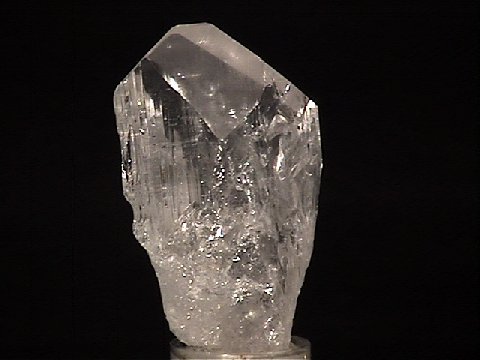
DANBURITE specimen dan-12
$ 25.00
$ 25.00
Dims: 1.5 x 0.9 x 0.7" (3.8 x 2.3 x 1.8 cm)
Wt: 16 g
San Bartolo Mine, Charcas, San Luis Potosi, Mexico
This single Danburite crystal is in moderately good condition, showing considerable damage to 3 of its 4 main prism edges. Its orthorhombic form is very good, and its clean, striated faces shine with a vitreous luster. The piece has a very faint pink tinge and is transparent and quite clear, containing a few internal fractures and inclusions. There is no host rock present.

dan-12 ($ 25.00)
San Bartolo Mine, Charcas, San Luis Potosi, Mexico
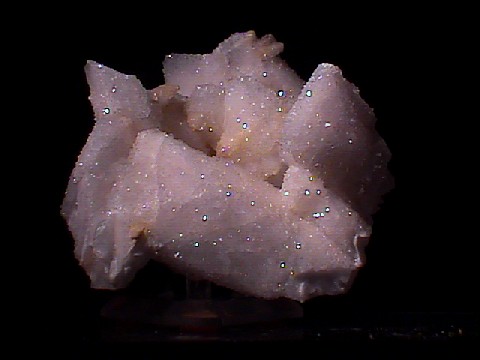
DANBURITE specimen dan-13
$ 96.00
$ 96.00
Dims: 3.4 x 3.0 x 2.4" (8.5 x 7.6 x 6.1 cm)
Wt: 11.5 oz. (327 g)
Charcas, San Luis Potosi, Mexico
A cluster of several large Danburite prisms comprises this cabinet specimen. The crystals are generally in very good condition- one or two are noticeably but lightly damaged- and reach dimensions of nearly 2.6 x 1.2 x 0.8" (6.6 x 3.0 x 2.1 cm). All appear to have excellent orthorhombic form. Their color is likely milky-white and their luster is likely vitreous, but I cannot be certain of their clarity, as all are coated with a druse of tiny quartz crystals. A few dull creamy calcites are also present.
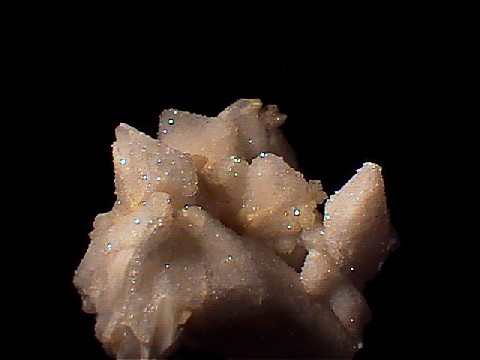

dan-13 ($ 96.00)
Charcas, San Luis Potosi, Mexico
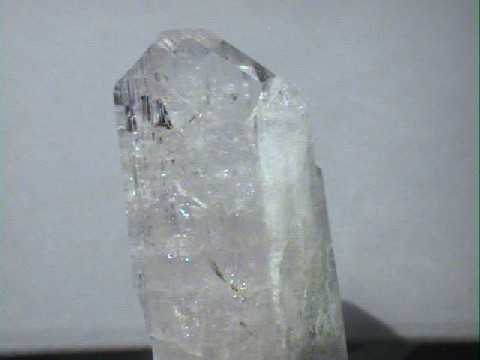
DANBURITE specimen dan-14
$ 25.00
$ 25.00
Dims: 2.9 x 1.3 x 0.7" (7.3 x 3.2 x 1.8 cm)
Wt: 2.0 oz. (58 g)
Charcas, San Luis Potosi, Mexico
A single large Danburite crystal makes up this small cabinet piece. The crystal is in very good condition, showing light damage along one prism edge, and has excellent tetragonal prismatic form; its termination is complex and symmetrical. The crystal has a very pale pink color and a vitreous luster, and is transparent and dimly to moderately clear due to rather intense internal fracturing. There is no base or host rock present.

dan-14 ($ 25.00)
Charcas, San Luis Potosi, Mexico
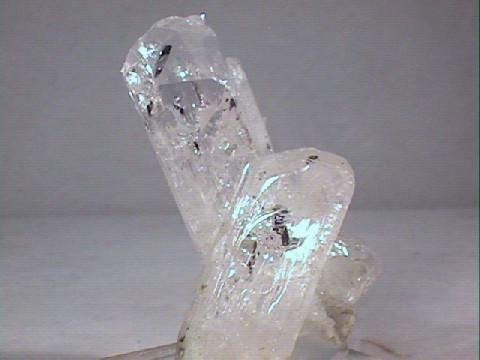
DANBURITE specimen dan-15
$ 38.00
$ 38.00
Dims:1.6x1.3x0.8" (4.1x3.3x2.0 cm)
Wt: 1.0oz. (29g)
Charcas, San Luis Potosi, Mexico
This is a specimen of Danburite crystals from the mines at San Luis Potosi. Two fully terminated crystals are intergrown on this specimen. Growing up from the base of the larger crystal, a much smaller crystal is a parallel growth on this piece. Another crystalline bit of danburite appears as a nodule of sorts near the base of the specimen. The tips of the two large crystals are of gem quality. The larger crystal is missing a tiny chip from one corner of its termination; otherwise, there is no noticable damage. This specimen is firmly glued to an acrylic base.

dan-15 ($ 38.00)
Charcas, San Luis Potosi, Mexico
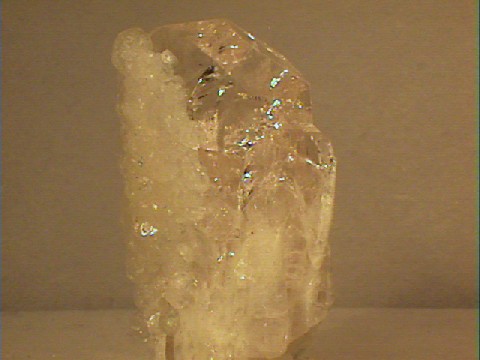
DANBURITE specimen dan-16
$ 52.00
$ 52.00
Dims:1.6x1.1x0.7" (4.1x2.8x1.8 cm)
Wt: 1.4oz. (39g)
Charcas, San Luis Potosi, Mexico
This specimen consists of a large crystal of danburite with two smaller parallel growth crystals. The back and left side of this piece is covered with a layer of small euhedral calcite crystals to 0.1" (0.3cm) in size. There is no noticable damage to this piece. This specimen strikes me as being unusually clear and gemmy-more so than other specimens of its size that I have handled. This piece is firmly glued on a clear acrylic base.


dan-16 ($ 52.00)
Charcas, San Luis Potosi, Mexico
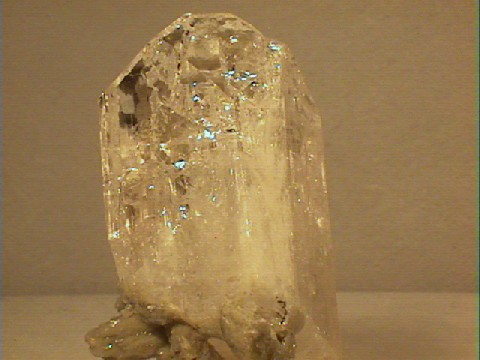
DANBURITE specimen dan-17
$ 30.00
$ 30.00
Dims:1.9x1.1x1.0" (4.8x2.8x2.5 cm)
Wt: 1.6oz. (44g)
Charcas, San Luis Potosi, Mexico
This specimen consists of a large danburite crystal with a smaller parallel growth crystal to one side. Small sprays (0.3", 0.8cm) of quartz crystals occur at the base and cover the back of this specimen. The termination of the parallel growth crystal is broken off; otherwise this specimen shows no damage. It is firmly glued to a clear acrylic base.

dan-17 ($ 30.00)
Charcas, San Luis Potosi, Mexico
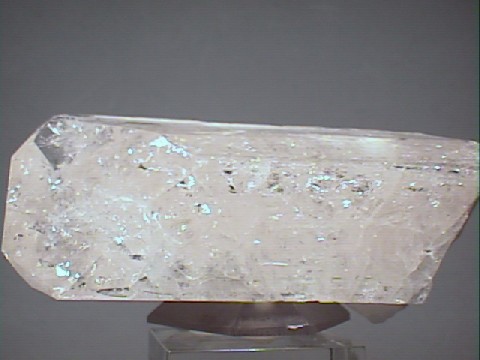
DANBURITE specimen dan-18
$ 60.00
$ 60.00
Dims:4.0x1.9x1.4" (10.1x4.8x3.6 cm)
Wt: 6.6oz. (188g)
Charcas, San Luis Potosi, Mexico
This is a large well-formed crystal of the mineral danburite. The crystal shows a moderate amount of internal fracturing. I believe that some of this fracturing was caused by the removal of other crystals growing near this one-damage on the prism faces of this crystal was undoubtedly caused by this. The tip of this crystal shows some transparency, and sports an excellent termination. Tiny black crystalline inclusions in the base and back of this specimen appear to be hornblende.
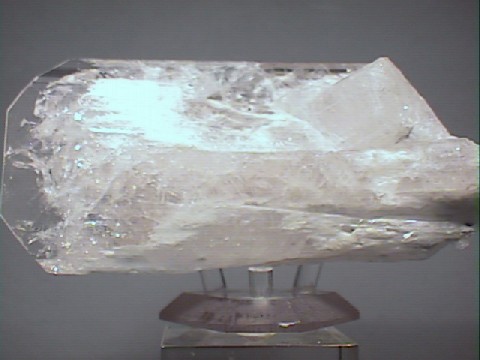

dan-18 ($ 60.00)
Charcas, San Luis Potosi, Mexico
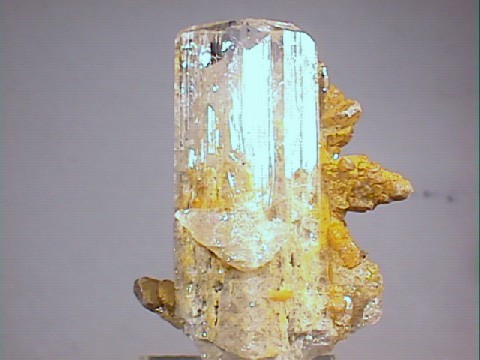
DANBURITE specimen dan-19
$ 25.00
$ 25.00
Dims:1.8x1.5x0.7" (4.6x3.8x1.8 cm)
Wt: 1.1oz. (31g)w/base
Charcas, San Luis Potosi, Mexico
This is a single crystal of danburite that shows some evidence of double termination. There is a radiating, cruciform-shaped cluster of iron-stained quartz crystals attached to the rear of this specimen. The lower half of the danburite crystal shows small solution cavities. There is a broken chip of danburite on the front of this specimen, where another crystal had grown, and was broken away. This is the only damage seen on this specimen. This piece is glued to a clear acrylic base.

dan-19 ($ 25.00)
Charcas, San Luis Potosi, Mexico
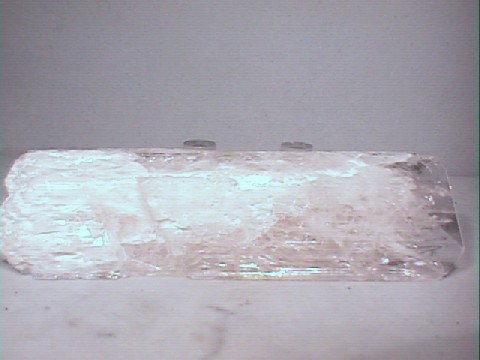
DANBURITE specimen dan-20
$ 33.00
$ 33.00
Dims:4.3x1.2x0.7" (10.9x3.0x1.8 cm)
Wt: 3.6oz. (102g)
Charcas, San Luis Potosi, Mexico
This specimen consists of a single large dandurite crystal, barren of any matrix. There are solution channels in the crystal, so that only near the tip is the crystal transparent. These channels on the outside of the crystal impart a crumbly texture in places. Some internal shattering can be seen within the crystal. There is a large chip out of the back where another crystal once was.

dan-20 ($ 33.00)
Charcas, San Luis Potosi, Mexico

DANBURITE specimen dan-22
$ 120.00
$ 120.00
Dims: 5.30x4.25x2.84" (13.47x10.79x7.21cm)
Wt: 35.80oz (1015g)
Charcas, San Luis Potosi, Mexico
THis is a nice cluster of large, prismatic danburite crystals. They are all milky-white in color, translucent, with tiny black inclusions lending an irregular gray tone. The crystals are striated, have a diamond-shaped cross section, and have uneven roof terminations. Several of the crystals are incomplete, including the largest for which part of the termination is missing, showing an uneven fracture.


dan-22 ($120.00)
Charcas, San Luis Potosi, Mexico

DANBURITE specimen dan-21
$ 25.00
$ 25.00
Dims mm=54.41x33.83x20.81
wt g=59.2
Charcas, San Luis Potosi, Mexico
This prismatic crystal of slightly pink danburite is exceedingly transparent, with internal fractures rendering the bulk of the crystal a milky pink. The sides show considerable damage, but the termination and faces are nearly flawless.


dan-21 ($ 25.00)
Charcas, San Luis Potosi, Mexico